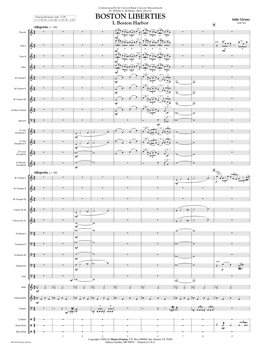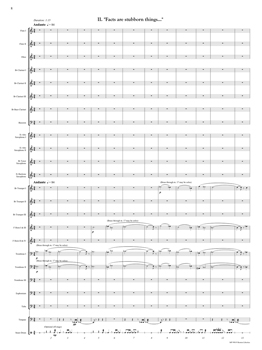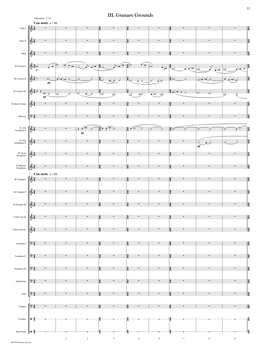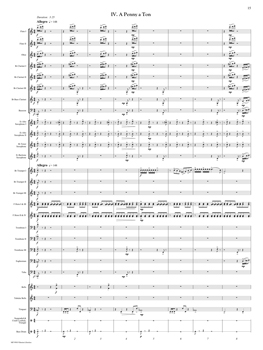Instrumentation
1 - Piccolo
4 - Flute 1
4 - Flute 2
2 - Oboe
4 - B♭ Clarinet 1
4 - B♭ Clarinet 2
4 - B♭ Clarinet 3
2 - B♭ Bass Clarinet
2 - Bassoon
2 - E♭ Alto Saxophone 1
2 - E♭ Alto Saxophone 2
2 - B♭ Tenor Saxophone
1 - E♭ Baritone Saxophone
2 - F Horn 1 & 3
2 - F Horn 2 & 4
3 - B♭ Trumpet 1
3 - B♭ Trumpet 2
3 - B♭ Trumpet 3
2 - Trombone 1
2 - Trombone 2
2 - Trombone 3
2 - Euphonium B. C.
2 - Euphonium T. C.
4 - Tuba
2 - Bells, Tubular Bells
1 - Timpani
3 - Percussion I (Suspended Cymbal,
Crash Cymbals, Triangle,
Snare Drum, Bass Drum)
Boston Liberties (9:30)
Grade 4
by Julie Giroux
I. Boston Harbor
II. "Facts are stubborn things..."
III. Granary Grounds
IV. A Penny a Ton
Premiered Saturday, March 8, 2003, Concord, Massachusetts,
by The Concord Band, Dr. William G. McManus, Music Director
Program Notes
I. Boston Harbor (2:10) – In search of religious freedom, John Winthrop from the Massachusetts Bay Company led eleven vessels full of Puritans into the area now known as Boston. More followed. As the years passed, the harbor would see the Boston Tea Party, the Revolutionary War, piracy, and a wealth of goods nearly beyond measure. Boston was the maritime center of America in colonial days. In the late 1800’s, thousands of immigrants, especially from Ireland, poured into the city and permanently changed its face. Many a long and perilous journey began or ended in the waters of Boston Harbor, which, to this day, has yet to share all of its secrets. I present this movement in a "traditional seafaring" and lighthearted swagger.
II. "Facts are Stubborn Things..." (1:15) – The killing of five men by British soldiers on March 5, 1770 referred to as the "Boston Massacre" is the basis for this movement. "Facts are Stubborn Things..." is a quote from John Adams’ legal papers, the speech that he presented to the jury. The music is divided into two sections with identical melodies. The melody represents "the facts." I twisted the accompaniment as far as I could without changing the melody (the facts), like two different people giving very different accounts of the same thing. I established the first "telling." The conductor, however, has total interpretive authority over the second.
III. Granary Grounds (2:15) – Granary Burying Grounds is where many notable Americans are interred, including patriots John Hancock, Paul Revere, James Otis, Robert Treat Paine and Samuel Adams. Also buried there are the victims of the "Boston Massacre," as well as whole families of settlers killed by fire and plague. This movement is a reflection of my own time spent wandering the grounds of historical cemeteries where I am always left with more questions than answers. Though some of the names are known, there are many that are not. I wonder what they looked like – what their lives were like. I wonder if they were loved, and if they loved. Mostly, I wonder if they have found peace. For my own peace of mind, and in this work, I pretend they all have.
IV. A Penny a Ton (3:25) – Boston Light was the first lighthouse built in North America and, in 1998, was the last one to be automated. If it had not been demolished in the Revolution, it would be the oldest, but today, it is considered the nation’s second oldest. The first lighthouse keeper, George Worthylake, lighted the tower for the first time on September 14, 1716. Worthylake was paid 50 pounds a year and also kept a flock of sheep there on Great Brewster Island. A storm caught his sheep on the long sand spit off Great Brewster and they drowned when the tide came in. Worthylake, his wife, and three others drowned when their overloaded canoe capsized. Benjamin Franklin, 12 years old at the time, wrote a poem about it.
Following Worthylake, Robert Saunders, a former sloop captain, became the second keeper. He also drowned within days of taking the appointment. The third keeper, John Hayes, was described as "able-bodied and discreet." Hayes asked for a fog signal of some kind and a cannon. And thus, America’s first fog signal was placed on the island in 1719.
In July 1775, Boston Harbor was under the control of the British. American troops were sent to burn the wooden parts of the lighthouse and they did so. The British began repairing it. Later that same month, more troops were sent, and again, burned the lighthouse. When they tried to leave, they found their boats stranded since the tide had gone out. American troops fired on British ships until the men could safely escape the island. The British finally left the lighthouse in 1776, but as a farewell present, set the lighthouse with charges and completely destroyed it. John Hancock ordered a new one to be built in design as close to the old one as possible. The federal government took over the lighthouse in 1789.
This programmatic movement depicts the mishaps, fog cannon, explosions, ship horns, rebuilding and constant operation of the tower, reflecting the determination of a people and a nation. The original Boston Light was financed by a tax of "A Penny a Ton" on all vessels coming into or leaving the harbor.
J.G.
IV Movements - Scroll to view
Click here to listen/view Mvt. 1
Click here to listen/view Mvt. II
Click here to listen/view Mvt. III


Home | Composers | Grade Levels | Order Form | Contact
©2010 Musica Propria, Inc.




